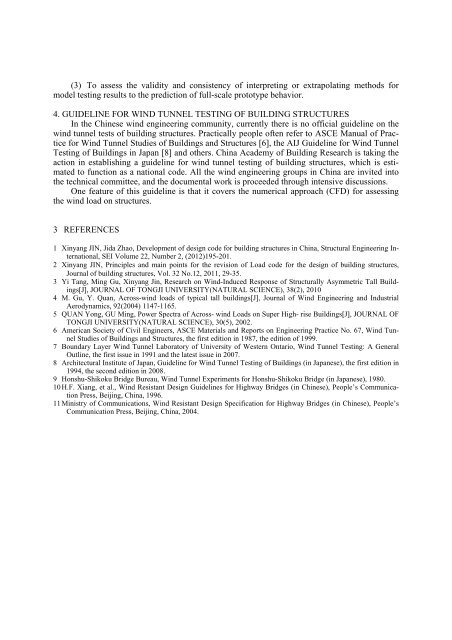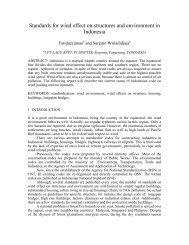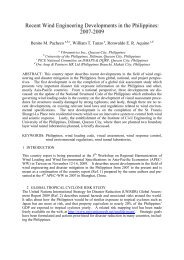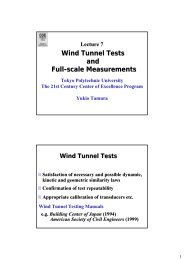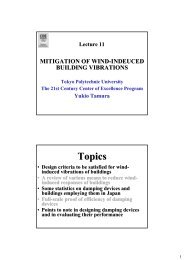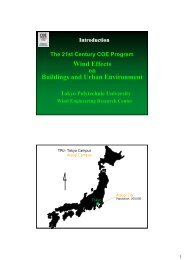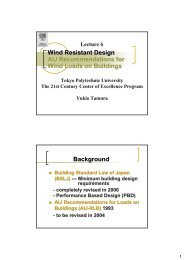Chinese Country Report 2012 - Revision of wind loading code and ...
Chinese Country Report 2012 - Revision of wind loading code and ...
Chinese Country Report 2012 - Revision of wind loading code and ...
You also want an ePaper? Increase the reach of your titles
YUMPU automatically turns print PDFs into web optimized ePapers that Google loves.
(3) To assess the validity <strong>and</strong> consistency <strong>of</strong> interpreting or extrapolating methods formodel testing results to the prediction <strong>of</strong> full-scale prototype behavior.4. GUIDELINE FOR WIND TUNNEL TESTING OF BUILDING STRUCTURESIn the <strong>Chinese</strong> <strong>wind</strong> engineering community, currently there is no <strong>of</strong>ficial guideline on the<strong>wind</strong> tunnel tests <strong>of</strong> building structures. Practically people <strong>of</strong>ten refer to ASCE Manual <strong>of</strong> Practicefor Wind Tunnel Studies <strong>of</strong> Buildings <strong>and</strong> Structures [6], the AIJ Guideline for Wind TunnelTesting <strong>of</strong> Buildings in Japan [8] <strong>and</strong> others. China Academy <strong>of</strong> Building Research is taking theaction in establishing a guideline for <strong>wind</strong> tunnel testing <strong>of</strong> building structures, which is estimatedto function as a national <strong>code</strong>. All the <strong>wind</strong> engineering groups in China are invited intothe technical committee, <strong>and</strong> the documental work is proceeded through intensive discussions.One feature <strong>of</strong> this guideline is that it covers the numerical approach (CFD) for assessingthe <strong>wind</strong> load on structures.3 REFERENCES1 Xinyang JIN, Jida Zhao, Development <strong>of</strong> design <strong>code</strong> for building structures in China, Structural Engineering International,SEI Volume 22, Number 2, (<strong>2012</strong>)195-201.2 Xinyang JIN, Principles <strong>and</strong> main points for the revision <strong>of</strong> Load <strong>code</strong> for the design <strong>of</strong> building structures,Journal <strong>of</strong> building structures, Vol. 32 No.12, 2011, 29-35.3 Yi Tang, Ming Gu, Xinyang Jin, Research on Wind-Induced Response <strong>of</strong> Structurally Asymmetric Tall Buildings[J],JOURNAL OF TONGJI UNIVERSITY(NATURAL SCIENCE), 38(2), 20104 M. Gu, Y. Quan, Across-<strong>wind</strong> loads <strong>of</strong> typical tall buildings[J], Journal <strong>of</strong> Wind Engineering <strong>and</strong> IndustrialAerodynamics, 92(2004) 1147-1165.5 QUAN Yong, GU Ming, Power Spectra <strong>of</strong> Across- <strong>wind</strong> Loads on Super High- rise Buildings[J], JOURNAL OFTONGJI UNIVERSITY(NATURAL SCIENCE), 30(5), 2002.6 American Society <strong>of</strong> Civil Engineers, ASCE Materials <strong>and</strong> <strong>Report</strong>s on Engineering Practice No. 67, Wind TunnelStudies <strong>of</strong> Buildings <strong>and</strong> Structures, the first edition in 1987, the edition <strong>of</strong> 1999.7 Boundary Layer Wind Tunnel Laboratory <strong>of</strong> University <strong>of</strong> Western Ontario, Wind Tunnel Testing: A GeneralOutline, the first issue in 1991 <strong>and</strong> the latest issue in 2007.8 Architectural Institute <strong>of</strong> Japan, Guideline for Wind Tunnel Testing <strong>of</strong> Buildings (in Japanese), the first edition in1994, the second edition in 2008.9 Honshu-Shikoku Bridge Bureau, Wind Tunnel Experiments for Honshu-Shikoku Bridge (in Japanese), 1980.10 H.F. Xiang, et al., Wind Resistant Design Guidelines for Highway Bridges (in <strong>Chinese</strong>), People’s CommunicationPress, Beijing, China, 1996.11 Ministry <strong>of</strong> Communications, Wind Resistant Design Specification for Highway Bridges (in <strong>Chinese</strong>), People’sCommunication Press, Beijing, China, 2004.


